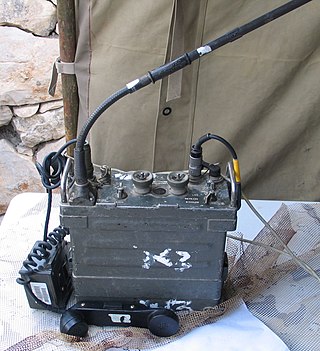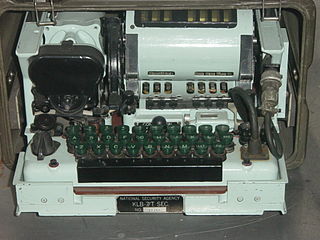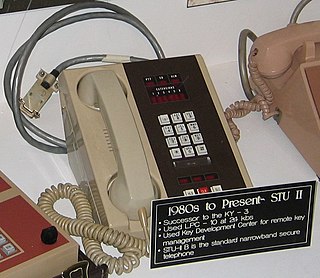
The National Security Agency (NSA) is an intelligence agency of the United States Department of Defense, under the authority of the Director of National Intelligence (DNI). The NSA is responsible for global monitoring, collection, and processing of information and data for global intelligence and counterintelligence purposes, specializing in a discipline known as signals intelligence (SIGINT). The NSA is also tasked with the protection of U.S. communications networks and information systems. The NSA relies on a variety of measures to accomplish its mission, the majority of which are clandestine. The NSA has roughly 32,000 employees.

Communications security is the discipline of preventing unauthorized interceptors from accessing telecommunications in an intelligible form, while still delivering content to the intended recipients.

The AN/PRC-77 Portable Transceiver, also known as AN/PRC 77 Radio Set, is a man-pack, portable VHF FM combat-net radio transceiver manufactured by Associated Industries and used to provide short-range, two-way radiotelephone voice communication. In the Joint Electronics Type Designation System (JETDS), AN/PRC translates to "Army/Navy, Portable, Radio, Communication."

The National Cryptologic Museum (NCM) is an American museum of cryptologic history that is affiliated with the National Security Agency (NSA). The first public museum in the U.S. Intelligence Community, NCM is located in the former Colony Seven Motel, just two blocks from the NSA headquarters at Fort George G. Meade in Maryland. The motel was purchased, creating a buffer zone between the high security main buildings of the NSA and an adjacent highway. The museum opened to the public on December 16, 1993, and now hosts about 50,000 visitors annually from all over the world.

STU-III is a family of secure telephones introduced in 1987 by the NSA for use by the United States government, its contractors, and its allies. STU-III desk units look much like typical office telephones, plug into a standard telephone wall jack and can make calls to any ordinary phone user. When a call is placed to another STU-III unit that is properly set up, one caller can ask the other to initiate secure transmission. They then press a button on their telephones and, after a 15-second delay, their call is encrypted to prevent eavesdropping. There are portable and militarized versions and most STU-IIIs contained an internal modem and RS-232 port for data and fax transmission. Vendors were AT&T, RCA and Motorola.

Secure Terminal Equipment (STE) is the U.S. government's current, encrypted telephone communications system for wired or "landline" communications. STE is designed to use ISDN telephone lines which offer higher speeds of up to 128 kbit/s and are all digital. The greater bandwidth allows higher quality voice and can also be utilized for data and fax transmission through a built-in RS-232 port. STE is intended to replace the older STU-III office system and the KY-68 tactical system. STE sets are backwards compatible with STU-III phones, but not with KY-68 sets.

The TSEC/KW-26, code named ROMULUS, was an encryption system used by the U.S. Government and, later, by NATO countries. It was developed in the 1950s by the National Security Agency (NSA) to secure fixed teleprinter circuits that operated 24 hours a day. It used vacuum tubes and magnetic core logic, replacing older systems, like SIGABA and the British 5-UCO, that used rotors and electromechanical relays.

The TSEC/KL-7, also known as Adonis was an off-line non-reciprocal rotor encryption machine. The KL-7 had rotors to encrypt the text, most of which moved in a complex pattern, controlled by notched rings. The non-moving rotor was fourth from the left of the stack. The KL-7 also encrypted the message indicator.
The National Security Agency took over responsibility for all US government encryption systems when it was formed in 1952. The technical details of most NSA-approved systems are still classified, but much more about its early systems have become known and its most modern systems share at least some features with commercial products.
The Secure Communications Interoperability Protocol (SCIP) is a US standard for secure voice and data communication, for circuit-switched one-to-one connections, not packet-switched networks. SCIP derived from the US Government Future Narrowband Digital Terminal (FNBDT) project. SCIP supports a number of different modes, including national and multinational modes which employ different cryptography. Many nations and industries develop SCIP devices to support the multinational and national modes of SCIP.
The KSD-64[A] Crypto Ignition Key (CIK) is an NSA-developed EEPROM chip packed in a plastic case that looks like a toy key. The model number is due to its storage capacity — 64 kibibits, enough to store multiple encryption keys. Most frequently it was used in key-splitting applications: either the encryption device or the KSD-64 alone is worthless, but together they can be used to make encrypted connections. It was also used alone as a fill device for transfer of key material, as for the initial seed key loading of an STU-III secure phone.
The 5-UCO was an on-line one-time tape Vernam cipher encryption system developed by the UK during World War II for use on teleprinter circuits. During the 1950s, it was used by the UK and the US for liaison on cryptanalysis.

Secure voice is a term in cryptography for the encryption of voice communication over a range of communication types such as radio, telephone or IP.

A secure telephone is a telephone that provides voice security in the form of end-to-end encryption for the telephone call, and in some cases also the mutual authentication of the call parties, protecting them against a man-in-the-middle attack. Concerns about massive growth of telephone tapping incidents led to growing demand for secure telephones.
Over-the-air rekeying (OTAR) refers to transmitting or updating encryption keys (rekeying) in secure information systems by conveying the keys via encrypted electronic communication channels. It is also referred to as over-the-air transfer (OTAT), or over-the-air distribution (OTAD), depending on the specific type, use, and transmission means of the key being changed. Although the acronym refers specifically to radio transmission, the technology is also employed via wire, cable, or optical fiber.

TSEC/KY-68 DSVT, commonly known as Digital Subscriber Voice Terminal, is a US military ruggedized, full- or half-duplex tactical telephone system with a built-in encryption/decryption module for secure traffic.

The STU-II is a secure telephone developed by the U.S. National Security Agency. It permitted up to six users to have secure communications, on a time-shared basis. It was made by ITT Defense Communications, Nutley, New Jersey. An OEM partner was Northern Telecom.
Fishbowl is a mobile phone architecture developed by the U.S. National Security Agency (NSA) to provide a secure Voice over IP (VoIP) capability using commercial grade products that can be approved to communicate classified information. It is the first phase of NSA's Enterprise Mobility Architecture. According to a presentation at the 2012 RSA Conference by Margaret Salter, a Technical Director in the Information Assurance Directorate, "The plan was to buy commercial components, layer them together and get a secure solution. It uses solely commercial infrastructure to protect classified data." Government employees were reportedly testing 100 of the phones as of the announcement.

NESTOR was a family of compatible, tactical, wideband secure voice systems developed by the U.S. National Security Agency and widely deployed during the Vietnam War (1955–1975) through the late Cold War period (1980s–1990s). NESTOR consists of three systems. The KY-8 was used in vehicular and afloat applications; the KY-28 was the airborne version; and the KY-38 was the portable or man-pack model. About 30,000 NESTOR equipments were produced prior to their replacement by the VINSON secure voice family.

SIGTOT was a one-time tape machine for encrypting teleprinter communication that was used by the United States during World War II and after for the most sensitive message traffic. It was developed after security flaws were discovered in an earlier rotor machine for the same purpose, called SIGCUM. SIGTOT was designed by Leo Rosen and used the same Bell Telephone 132B2 mixer as SIGCUM. The British developed a similar machine called the 5-UCO. Later an improved mixer, the SSM-33, replaced the 131B2.













